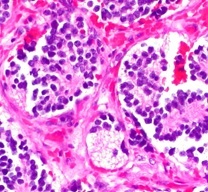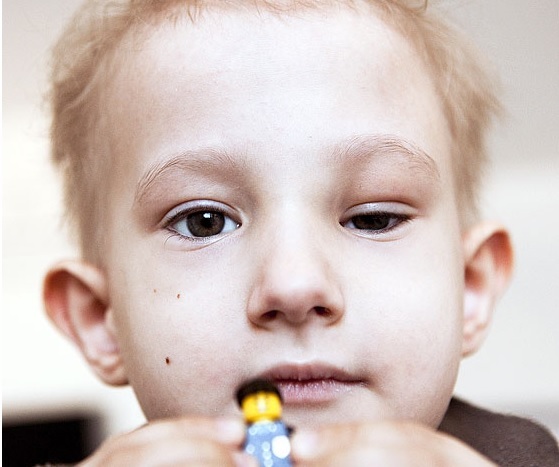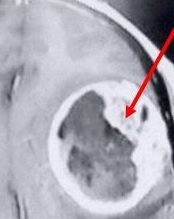Neuroblastoma is a mysterious malignant tumor of childhood
Contents:
- Characteristics of the disease
- Features of the disease
- Clinical picture: characteristic symptoms
- Principles of diagnosis and treatment
- Forecast
 In recent years, the incidence of neoplasm in children has increased. Malignant lesions of organs and tissues in patients under 18 years of age are more aggressive, therefore it is especially important to follow the principles of early diagnosis( see Brain Cancer).One of the frequent tumors in childhood is neuroblastoma - and what is it?
In recent years, the incidence of neoplasm in children has increased. Malignant lesions of organs and tissues in patients under 18 years of age are more aggressive, therefore it is especially important to follow the principles of early diagnosis( see Brain Cancer).One of the frequent tumors in childhood is neuroblastoma - and what is it?
Characteristics of the disease
 Neuroblastoma is a malignant lesion of the tissues of the sympathetic nervous system. It refers to undifferentiated tumors and has an acute course. Morphologically the new formation is small cells with deformed dark-spotted nuclei.
Neuroblastoma is a malignant lesion of the tissues of the sympathetic nervous system. It refers to undifferentiated tumors and has an acute course. Morphologically the new formation is small cells with deformed dark-spotted nuclei.
Neuroblastoma( photo under the microscope), is considered a child's disease. Although this fact is not confirmed scientifically, there is no information about the primary disease in adults in the official medicine. In 90% of cases, neuroblastoma is diagnosed before the age of 5 years. Sometimes the disease manifests itself from birth. The older the child, the lower the likelihood of developing this oncology.
Features of the disease
The causes and mechanism of development of the oncological pathology of the sympathetic nervous system are not fully understood. There are several theories of the origin of the disease, but so far none of them have been scientifically confirmed. Neuroblastoma in children, the symptoms of which we will consider below has a number of distinctive features:
- Ability to aggressive fast flow and active spread of distant metastases.
- The possibility of maturation - the transformation of undifferentiated cells into more mature cells, which means less malignant cells. In rare cases, the disease itself is transformed into a ganglioneuromus - a benign tumor of the nervous tissue.
- Ability to regress: the disease can spontaneously disappear even if there are significant sizes and distant metastases.
- No relapse: with successful treatment, the risk of recurrence is minimal, even if tumor cells remain in the body.
 How the meningioma of the brain manifests itself. Principles of treatment of pathology.
How the meningioma of the brain manifests itself. Principles of treatment of pathology.
What is adenoma of the pituitary gland of the brain read here.
Clinical picture: characteristic symptoms of
Since the nerves of the sympathetic nervous system are spread throughout the body, the localization of the tumor can be different. Most common:
- neuroblastoma of retroperitoneal space;
- of adrenal neuroblastoma;
- mediastinal neuroblastoma;
- of neuroblastoma in the neck.
Symptoms of the disease are largely dependent on the location of the tumor and the degree of spread of metastases. Small patients may complain about:
- abdominal pain;
- poor appetite, weight loss;
- weakness, lethargy, fatigue.
Neuroblastoma of the retroperitoneal space additionally has the following symptoms:
- is a tumor that can be probed in the abdomen;
- swelling of the tissues;
- fever - a constant increase in body temperature at a level of 37-38 degrees;
- anemia - a sharp pallor, a decrease in the concentration of hemoglobin in the blood;
When the tumor grows into the spinal canal - the formation of a stone density, which can be felt on the back in the projection of the spine.
If neuroblastoma is formed by a mediastinal neural tissue, the child develops constant regurgitation, coughing, difficulty in swallowing solid food, trouble breathing. When germinating in the bone and bone marrow, it is possible to develop a hemorrhagic symptom( increased bleeding) and acute pain during movement. Neuroblastoma of the retrobulbar space is characterized by a specific "syndrome of glasses" and exophthalmos( protrusion of eyeballs from the orbit).
Most often the tumor metastasizes in:
- round and tubular bones;
- bone marrow;
- lymph nodes;
- liver;
- skin;
- brain.
 There are 4 stages of the disease:
There are 4 stages of the disease:
- I - characterized by a single tumor formation up to 5 cm in diameter without damage to the lymphatic system and distant metastases;
- II-the tumor size measures 5-10 cm, the lymph nodes and the distant organs are not affected;
- Stage III is diagnosed with any development of the neoplasm in the event that lymph nodes are involved in the tumor process.
- Neuroblastoma 4 stages: what is it? Such a diagnosis is made for any tumor size, but the presence of metastases or in the case when the patient is diagnosed with multiple neoplasms of sympathetic nervous tissue.
Principles of Diagnosis and Treatment of
The reason for contacting a doctor is usually some of the signs of the disease described above. In this case, if neuroblastoma develops in adults, the symptoms remain similar to the infantile form of the disease. If there is a suspicion of a malignant tumor of nervous tissue, the patient will have a serious examination( see Diagnosis of brain tumors), including:
- determining the size and location of the primary focus and metastases: ultrasound, CT, MRI, scintigraphy;
- control of biochemical markers of tumor growth: determination of dopamine, homoviniline and vanillylmandelic acids;
- definition of the morphological composition of the tumor: a biopsy with a histological study of the biopsy.
The treatment plan in each case is determined by the oncologist on an individual basis. As a rule, it includes:
- surgical removal of the neuroblastoma itself and the lymph nodes involved in the tumor process;
- radiotherapy;
- chemotherapy, reception of cytostatics( Vincristine, Teniposide, Cyclophosphamide, etc.);
- bone marrow transplantation.
In the I and II stages of the disease, the main surgical method remains. Before it is recommended to conduct 1-2 courses of chemotherapy, which is able to reduce the size of the primary focus and significantly reduce the risk of distant metastases. IV and sometimes III stage requires complex treatment, including the above methods, as well as the impact on the tumor of radioactive radiation.
 What is glioblastoma multiforme? Prognosis for the life of patients.
What is glioblastoma multiforme? Prognosis for the life of patients.
What brain tumors can be read here.
Learn about neurinoma of the brain from this article: http: //golmozg.ru/zabolevanie/ nevrinoma-golovnogo-mozga.html. Diagnosis and treatment of pathology.
Forecast
Unfortunately, most cases of neuroblastoma are diagnosed in later stages, when the prognosis remains unfavorable( five-year survival is guaranteed only 10-30% of patients).It is easier for the disease to occur in young children, especially if there are no metastases to the bone marrow. With a comprehensive approach to treatment, the survival of patients with a tumor in the early stages is 90-100%.
write the question in the form below:



